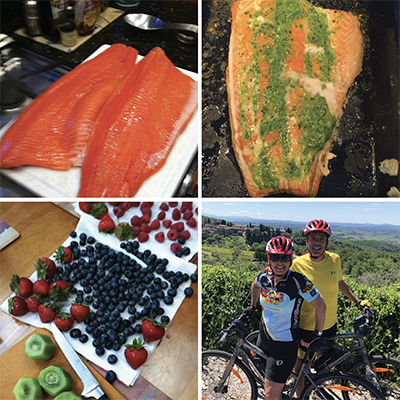 Researchers have found links between eating a pro-inflammatory (bad inflammation) diet and increased fractures in women, as well as an increase in osteoarthritis in both men and women. As we age, pain and fractures are very real concerns, and smarter lifestyle decisions can help us stay strong and pain-free!
Researchers have found links between eating a pro-inflammatory (bad inflammation) diet and increased fractures in women, as well as an increase in osteoarthritis in both men and women. As we age, pain and fractures are very real concerns, and smarter lifestyle decisions can help us stay strong and pain-free!
Certain foods are considered “anti-inflammatory” and good for you! Salmon, for example, is a well-known source of omega-3 fatty acids and has been shown to decrease systemic inflammation. The fatty acids, eicosapentaenoic acid (EPA) and docosahexaenoic acid (DHA), can improve functional ability and reduce pain in a myriad of conditions, including osteoarthritis. Onions and garlic both possess anti-inflammatory agents (quercetin) that help with chronic pain. Blueberries and strawberries contain the antioxidant anthocyanin which can help in inflammatory conditions. Resveratrol is found in high concentrations in strawberry seeds, as well as red wine, which has cardiovascular-protective properties as well as anti-cancer properties.
Pro-inflammatory foods that should be avoided: Sugar is one of the top inflammatory foods! Others include trans and saturated fats, fried foods, processed meat, refined carbohydrates, and artificial sweeteners/additives. Choosing fresh, whole foods instead of pro-inflammatory foods as often as possible has far-reaching effects on our health, including our joints.
What about obesity and OA? In the September 2021 issue of Postgraduate Medicine, “Obesity is a major risk factor for development and worsening of osteoarthritis. Managing obesity with effective weight loss strategies can improve patients’ osteoarthritis symptoms, functionality, and quality of life. However, little is known about the clinical journey of patients with both osteoarthritis and obesity. This study aimed to map the medical journey of patients with osteoarthritis and obesity by characterizing the roles of health care providers, influential factors, and how treatment decisions are made.” What did the researchers find – 90% of patients are trying to lose weight. However, the study showed that less than 20% of physicians think their patients are motivated to lose weight.
What can be done? Here are some simple tips to consider:
- Set realistic goals to lose weight slowly, around 1-2 pounds per week. Make lifestyle changes vs going on a “diet.”
- Consistency. This applies not only to eating, but also exercise. The older we get, the more we realize we must be consistent with our eating patterns and our exercise. Your weight and general health will reflect what you do and eat most frequently.
- Exercise burns fat quickly and gives you energy.
- Work on muscle building. Just doing small amounts of weight training and/or CORE training can make a big difference (especially for women). Muscle burns more than fat.
- Metabolic rate. Raising your metabolic rate will use energy which either burns fat or stops fat from being stored. Exercise will raise your metabolic rate. We have also found that spicy/hot foods can also contribute.
Obesity not only stresses joints, but the fat you accumulate also creates inflammation. The decline in muscle mass and strength, known as sarcopenia, is strongly associated with frailty, cardiometabolic dysfunction, physical disability, and even death!Successful approaches for fat loss while preserving lean and bone mass are critical to reduce the aging- and obesity-related physical and metabolic complications and at the same time avoid frailty and development of OA. Here you have it again – more reasons to eat fresh and keep moving! See you out there on the multi-use paths!



